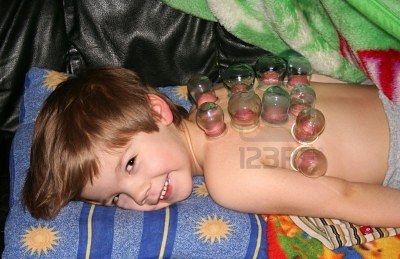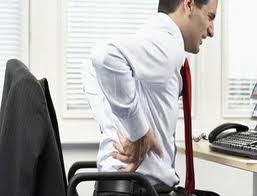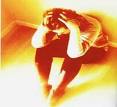
www.massagemag.com The Art of Massage Cupping
By Anita J. Shannon
An ancient technique has
found its place in the modern world of healing. Massage cupping
is a modified version of the common practice of cupping therapy,
used in traditional Chinese medicine (TCM), and the results that
this simple treatment produces are impressive. Through suction
and negative pressure, massage cupping releases rigid soft tissue;
drain excess fluids and toxins; loosen adhesions and lift connective
tissue; and bring blood flow to stagnant skin and muscles.
The therapeutic applications
of cupping have been documented through several thousand years of
clinical experience. Cupping is used extensively in TCM and has
now been adapted for other health-care modalities, including massage
therapy and chiropractic. Massage cupping intensifies the therapeutic
aspect of traditional cupping and is an effective addition to any
spa, healing facility or private practice. The cups are inexpensive,
the therapy is fun and result-oriented, and the client response
is remarkable.
A Cup of History
Cupping developed over time from the original use, by various indigenous
peoples, of hollow animal horns to drain toxins out of snakebites
and skin lesions. Horns evolved into bamboo cups, which were eventually
replaced by glass. Therapeutic applications evolved with the refinement
of the cup itself, and with the cultures that employed cupping as
a health-care technique.
The Chinese expanded the use
of this technique to surgery, to divert blood flow from the surgery
site. Cupping eventually developed into a separate therapy under
the TCM umbrella, with healers trained specifically in this technique.
Other ancient cultures, including the Egyptians and early Greeks,
embraced the therapeutic value of cupping. The technique eventually
spread throughout Europe and later to the Americas.
Cupping was common in households
of the 18th, 19th and early 20th centuries. Indeed, many people
still remember Grandma cupping their back for congestion and colds.
European and American doctors used cupping into the late 1800s,
and cupping sets were still carried by medical-supply companies
well into the 1940s. Breast cupping became common for inflamed breasts
and lactation dysfunctions, and the familiar breast pump evolved
from this practice.
With this rich history of
medical application, how does cupping fit into current health practices?
Massage cupping, or the use of glass cups, held by suction, to massage
the body, can be added into almost any massage or bodywork session.
The action on the nervous system is sedating, and clients will often
experience a deep state of relaxation.
"After a number of sessions
of massage cupping, I have experienced cumulative and lasting benefits,"
says Julie Hanson, a cupping client in Asheville, North Carolina,
who suffered chronic muscle spasms in her shoulders and neck due
to a torque in her spine.
"[The spasms] seemed
exhaustingly permanent and have never been relieved by traditional
methods of massage," she says. "Cupping, however, has
produced marked improvements in posture and muscle position that
are nothing short of exhilarating."
 A
favorite area for massage cupping is on the broad area of the back.
Larger cups are used for this, and a strong vacuum will mimic the
rolling action of deep-tissue massage without any discomfort. The
movement may be long and intended to drain fluid, or circular and
stimulating for stubborn knots and areas of rigid tissue. The skin
will turn red with strong massage cupping, indicating that circulation
has been brought to the surface. A
favorite area for massage cupping is on the broad area of the back.
Larger cups are used for this, and a strong vacuum will mimic the
rolling action of deep-tissue massage without any discomfort. The
movement may be long and intended to drain fluid, or circular and
stimulating for stubborn knots and areas of rigid tissue. The skin
will turn red with strong massage cupping, indicating that circulation
has been brought to the surface.
Application of liniments,
analgesics, plant hydrosols and essential oils immediately after
the treatment will facilitate the absorption of the product deep
into the tissue. The increased local blood supply to the muscles
and skin will bring nourishment and allow for toxins to be carried
away through the veins. Clients often feel deep warmth during the
session and a tingling sensation long after the treatment has ended.
Massage cupping is not an
irritant to the skin or body. It draws the inflammation out, yet
does not add to it. This technique is excellent when used as a contrast
therapy with cold compresses or liniments. The cups may also be
manipulated to mimic other massage techniques without the normal
stress on the hands of the therapist.
A Typical Session
The supplies that are needed for this technique are minimal: cups;
isopropyl or de-natured alcohol; cotton balls; a candle and lighter;
and clamps to hold the cotton. Place the candle (in a holder) on
a towel, and light it. Hold a cotton ball in the clamps and add
5-10 drops of alcohol. Move the cotton over the candle flame to
light it, and then insert it into a glass cup to create a vacuum.
Quickly move the cup over to the area to be worked on, remove the
cotton ball and invert the cup onto the body. The heat creates a
seal that adheres to the body. If the seal breaks, simply repeat
the process. If using a manual vacuum set, place the cup on the
body and activate the pump to remove air.
There are two main uses of
cupping: stationary and in massage. Stationary cupping is used in
TCM to clear stagnation of blood; to facilitate the release of pathogenic
factors; and to dispel internal heat. Cups are placed on the skin
and left for five to 15 minutes. Four to six cups may also be applied
and then removed cyclically in a technique called flash cupping.
Both methods are commonly used for treating lung congestion and
for removing heat from the body. The stimulation on the back, over
the lungs, activates the ciliary escalator of the lungs and facilitates
expectoration of congested material. The other action is to bring
heat from the lungs to the surface of the skin to be eliminated.
Stationary cupping sometimes results in rings and circles on the
back as toxins and blood move to the surface.
Cupping used for massage is
the more common form among practitioners of Western healing arts.
Before applying the cups, administer plenty of oil on the areas
to be cupped, to facilitate smooth movement. Take this opportunity
to palpate areas of tension and congestion. Place the cup on the
area, grasp it with one or two hands, and begin to glide it over
the skin. The movement should be smooth, without pressing down,
as this will inhibit the suction effect.
Pressure Matters
Always ask the client if the pressure is uncomfortable in any way.
Almost all areas of the body may be worked on, including the neck,
shoulders, middle and low back, and sacrum. The stomach, hips and
thighs require a gentler suction.
Watch closely to determine
the circulatory reaction and adjust the suction as needed. It is
a good idea to start with a medium to light pressure and increase
slowly. Marks may occur with very strong cupping - and while this
may be considered beneficial in TCM, this is usually not the way
to send a client home from her massage. Be sure to acquire proper
training and then practice on family, friends and co-workers before
working on clients.
Remember that the intensity
of the cupping depends on a few factors:
1) How quickly the cup is placed on the skin after the flame is
removed.
2) The strength of the flame (certain alcohol burns hotter than
others).
3) The size of the cup.
4) If using a vacuum set, the pump will determine the suction.
There are additional safety
considerations to be aware of when integrating cupping into your
practice. Most of them are common sense, yet ought to be seriously
considered. This is one of the greatest reasons to acquire adequate
training before starting to work on clients.
Cup Creatively
Some of the most enjoyable aspects of this technique are the subtle
nuances of the movements. Creativity provides a variety of methods,
and alteration of pressure and speed produce amazingly different
sensations.
The edge of the cup can be
used to "scoop" in a cross-fiber movement, and vigorous
circles feel marvelous on the hips, thighs and shoulders. Long strokes
down the sides of the spine and along the ribs provide ease of movement
for ribcage expansion and breathing. Stubborn neck tension is soothed
with a gentle approach.
Clients respond to the experience
with positive feedback, often reporting that the treatment stayed
with them longer than most sessions and was cumulative in its effects.
"I had pain in my upper
arms for over 20 years in a specific spot where the mid-deltoid
meets the lateral side of the biceps," says Gail Gordon, another
cupping client in Asheville, North Carolina. "Within three
months [of monthly cupping sessions] the pain was completely gone.
I have more range of motion than I have had in years in that area."
Numerous conditions respond
beautifully to massage cupping, including fibromyalgia, anxiety,
insomnia, post-injury trauma, chronic pain, post-surgery adhesions,
cellulite and sluggish colon.
Brenda Sinners, a massage-cupping
practitioner in Ocean Isle, South Carolina, says cupping visibly
improved one client’s knee injury.
"I only did a bit of
the cupping around her knee, but that led me to her hip, around
the piriformis, of the same side," she says. "I actually
parked it there for a few minutes when she said she could feel it
in her knee. When she got up, her knee was less swollen, plus she
could walk with no limp."
Therapist Benefits
Another beneficial aspect of cupping is the ease for the practitioner.
This method allows respite for the hands from repetitive movement
and enables the therapist to get deeper without discomfort to the
client or herself.
Massage cupping continues
to evolve as new equipment is located and creative applications
are discovered. A small micro-cup set has led to a new technique
used to drain and lift the face, loosening tight facial muscles
and stimulating blood flow to the skin. Temporomandibular joint
(TMJ) disorders also respond well. This is a quick yet effective
addition to a facial, massage or body treatment.
Adding massage cupping to
a treatment should result in an additional charge of $5-15 per session,
with no increase in time or cost for the practitioner.
One way to begin to learn
more about this incredible therapy is to experience it. There are
not many massage-cupping practitioners at this time, yet interest
is growing as more therapists are exposed to this technique. Massage
cupping is sure to prove itself a viable addition to our efforts
in assisting our clients on their healing path. | 
















